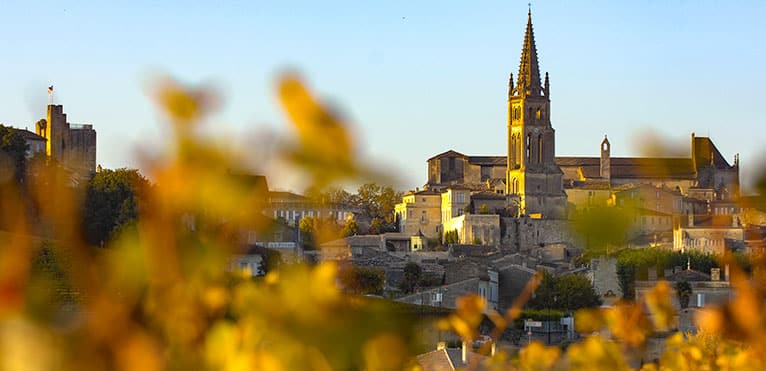
Contents
Puisseguin-Saint-Émilion is an appellation located on the right bank of the Bordeaux vineyards, to the east of the famous commune of Saint-Émilion, in the Libourne wine-growing region. Puisseguin-Saint-Émilion is a dry red wine, one of the so-called “still” wines, with the dual AOC-AOP appellation. The wineries in the commune of Puisseguin-Saint-Émilion are often very small and little-known, but they do hold some nice surprises.
Puisseguin-Saint-Émilion owes its name to Lieutenant Seguin
Vines have been present in the Bordeaux region for over 2,000 years, so winegrowing has been widespread in the region since antiquity, although it developed particularly from the 18th century onwards with new techniques and the start of exports.
In addition, the appellation and its eponymous commune owe their name to the contraction of the two words Puy and Seguin. Puy comes from the Latin Podium, meaning “land” or “mountain”. Seguin was a loyal lieutenant of Charlemagne, who settled in the area around 800 AD. The commune of Puisseguin-Saint-Émilion and its surrounding area is well known for having been at the heart of numerous oppositions, as confirmed today by the presence of numerous fortified castles and underground passages in the region.
The appellation was recognized as an AOC in 1936, as were most of the other Appellations d’Origines Contrôlées in the Bordeaux region. Within the latter, châteaux have a basic yield of around 45 hectolitres per hectare. Because the AOC is so small, Puisseguin-Saint-Émilion wines account for just 1% of total Bordeaux wine production.
Puisseguin is one of Saint-Émilion’s four satellites
Puisseguin-Saint-Émilion is located in the Libourne wine region, on the right bank of Bordeaux. Along with the communes of Saint-Georges-Saint-Emilion, Lussac-Saint-Émilion and Montagne-Saint-Émilion, it is one of the satellite vineyards to the northeast of Saint-Émilion.
The 750 hectares of vines in Puisseguin-Saint-Émilion benefit from an oceanic climate, which ensures relatively mild temperatures in winter and avoids severe drought in summer. What’s more, these same hectares benefit from plenty of sunshine and efficient drainage thanks to the region’s relief and hills. These weather conditions are ideal for growing vines, resulting in an annual production of 35,000 hectoliters of red wine.
The soils of Puisseguin-Saint-Émilion are composed of sandy-clay and gravelly soils. There are clays and blue clays, very beneficial to the development of Merlot. Similarly, the gravelly soil is ideal for growing Cabernet Sauvignon. Nevertheless, a stone base, anchored deeper into the soil, makes the land difficult to cultivate in places.
Merlot, the emblematic grape variety of AOC Puisseguin-Saint-Émilion
Several grape varieties are included in the appellation’s specifications. However, the the predominant grape for this red wine is Merlot. It represents 80% of the total grape variety. Cabernet-Sauvignon, Cabernet-Franc and Malbec are the other grape varieties used, but in much smaller quantities.
Like most Bordeaux wines, Puisseguin-Saint-Émilion has a lovely ruby-red color with purplish highlights. Their reflections sometimes turn brown as they age. The nose, for its part, offers first notes of red or black fruit (strawberry, cherry, blackcurrant…), even stone fruit (such as prune in warm years). In addition, notes of vanilla and leather reveal the barrel age. In the best vintages of Puisseguin Saint-Émilion, we also find very pleasant aromas of candied fruit. In addition, the firm but fine tannins give way to a fleshy, round mouthfeel.
These wines generally have an ageing potential of between 5 and 10 years. Puisseguin-Saint-Émilion’s most remarkable vintages are 1989, 2009 and 2016, recognized as exceptional vintages, 1990 as the vintage of the century, and 1982 and 2005 as the vintages of the millennium.
Puisseguin-Saint-Émilion and ceps stuffed Bordeaux-style
The wines of this appellation are described as full-bodied, with a fine, fleshy texture and delicate tannins. They go equally well with red meat, game and certain cheeses. They are renowned for being the perfect accompaniment to duck confit with sorrel or ceps stuffed bordelaise-style. Finally, as with most red wines, these should be enjoyed at between 15 and 17 degrees Celsius.
Puisseguin’s flagship estates
Château La Croix Teynac
The château’s cultivated area of 30-year-old vines exceeds 20 hectares. The grape varieties are 85% Merlot and 15% Cabernet Franc, and the vines are grown on clay-limestone terroir. Harvesting is mechanical, and the grapes spend 22 days in vats. In 2010, the château’s still red wine won a gold medal at the Bordeaux wine competition.
François Saurue vineyards
This wine estate in Puisseguin Saint Emilion is planted on 16 hectares of vines spread over different communes. Of these 16 hectares, 5 hectares are located in Puisseguin-Saint-Émilion, 3.5 hectares in Saint-Émilion, 2 hectares in Maury, 2 hectares in Montagne Saint-Émilion, 2 hectares in Castillon Côte-de-Bordeaux and 2 hectares in Lussac Saint-Emilion.
Cultivation is carefully thought out, with one row of soil in every other and natural grass cover. As far as treatments are concerned, these vineyards are monitored by the Aquitaine Chamber of Agriculture and the GDON (Groupement de Défense contre les Organismes Nuisibles) with the aim of minimizing phytosanitary treatments.